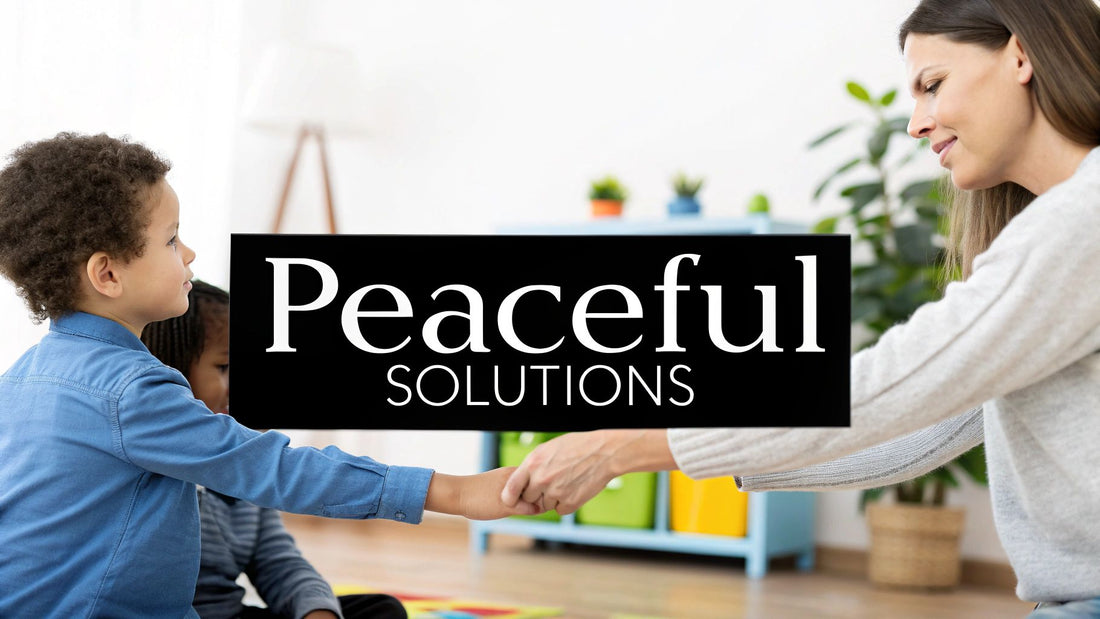
Effective Conflict Resolution Techniques for Kids That Work
Share
Teaching your child how to handle disagreements isn't just about putting a stop to sibling squabbles over the TV remote. It's one of the most practical and powerful life lessons you can give them, setting them up for better long-term mental health. These skills give them the tools to manage arguments constructively, turning what could be stressful moments into chances to build resilience.
Why Conflict Resolution Skills Are a Cornerstone of Wellbeing
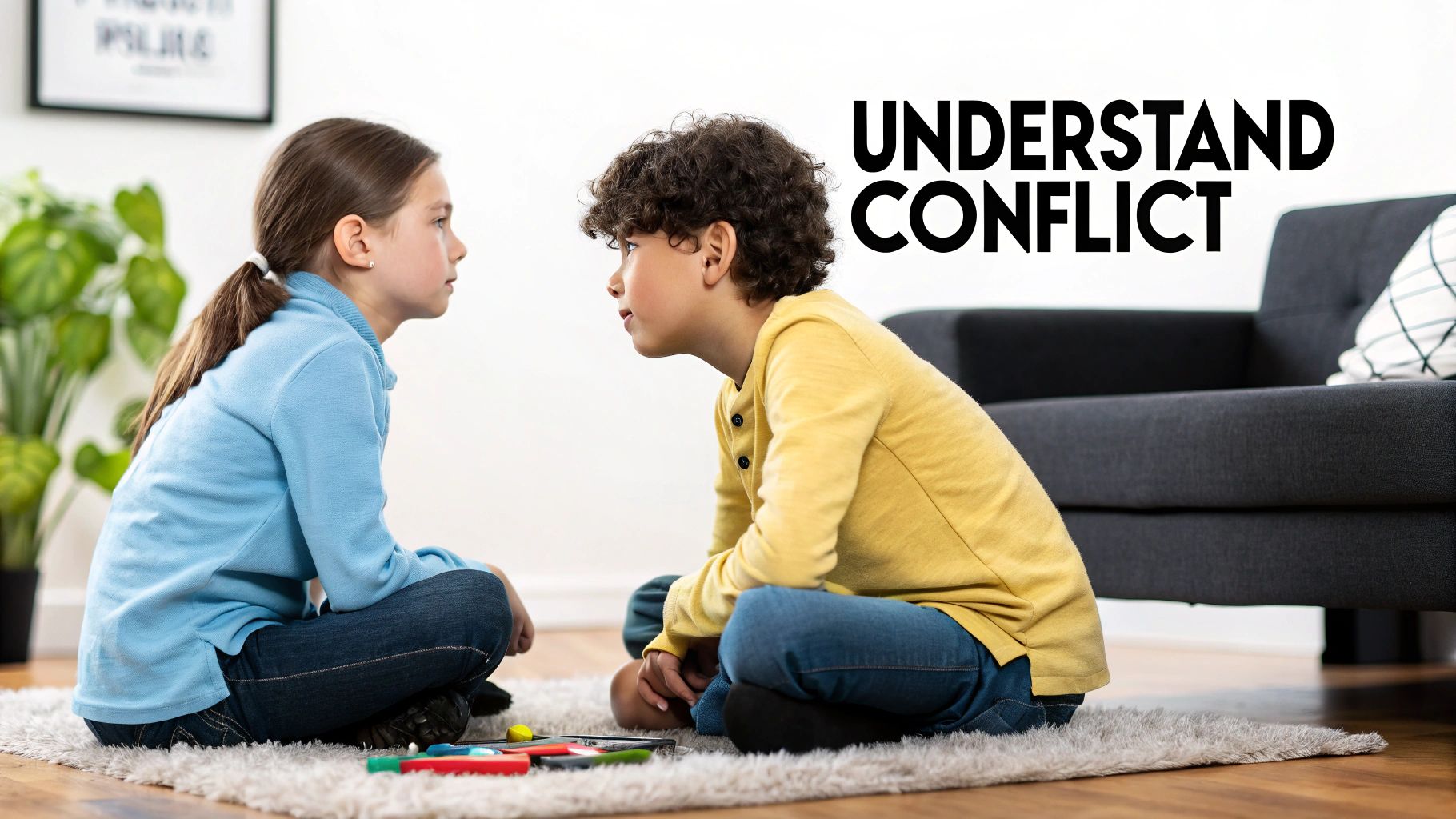
Learning to navigate a falling out is about so much more than just keeping the peace at home. It’s a core part of building a child’s emotional strength and protecting their mental health for the future. When kids learn how to voice what they need whilst also listening to someone else's side, they are developing skills that will see them through everything from playground politics to workplace negotiations.
The state of children's mental health here in the UK is a real worry. One in five children and young people in England have a probable mental health condition. Young people are under immense pressure, and it's often made worse by social media, where a simple disagreement can blow up very quickly and very publicly. By teaching them how to sort things out face-to-face, we're giving them a toolkit to handle their online worlds with more confidence and a lot less anxiety.
Think about it: a child who can say, "I feel upset when you take my toy," instead of just lashing out, has mastered a vital self-regulation skill. This ability to explain their feelings without pointing fingers is a complete game-changer for building healthy, lasting friendships.
The Lifelong Benefits of Early Skills
The payoff for mastering conflict resolution stretches far beyond childhood. These skills are directly linked to better mental wellbeing, higher self-esteem, and stronger friendships. The long-term impact is huge:
- Building Healthy Relationships: Kids who can work through conflicts are simply better at making and keeping friends. They learn empathy, how to compromise, and respect—the bedrock of any solid relationship.
- Developing Resilience: Life is full of disagreements; that's a given. A child who learns to see conflict as a problem that can be solved, rather than a total disaster, is far better equipped to bounce back from all sorts of setbacks.
- Reducing Stress and Anxiety: Unresolved arguments are a massive source of stress. Giving children a clear framework for handling disputes helps them feel more in control and less overwhelmed by social challenges.
The atmosphere at home plays a massive part in how children see and handle conflict. Recent UK government statistics revealed that 10% of children in couple-parent families have a parent who reports relationship distress. For these kids, seeing adults model constructive ways to disagree is absolutely vital for their own mental health. You can explore more data on parental conflict to understand the full picture.
The Broader Impact on Society
The importance of these skills even scales up to the world of work. Poor mental health costs UK employers up to £56 billion a year due to lost productivity and staff turnover. A significant portion of this stems from unresolved workplace conflict. By teaching these skills early on, we are preparing a future generation of employees who are more collaborative, communicative, and emotionally intelligent. That’s a direct benefit to our economy and workplace wellbeing.
Ultimately, teaching conflict resolution techniques for kids is an investment in their future happiness and success. It’s about empowering them to build a life filled with positive connections and giving them the confidence to handle whatever challenges come their way.
Please Note: I am a parenting strategist sharing insights and techniques, not a registered mental health professional. If you have serious concerns about your child's mental health or behaviour, it is always best to seek advice from your GP or a qualified child psychologist.
Building Your Child's Emotional Toolkit
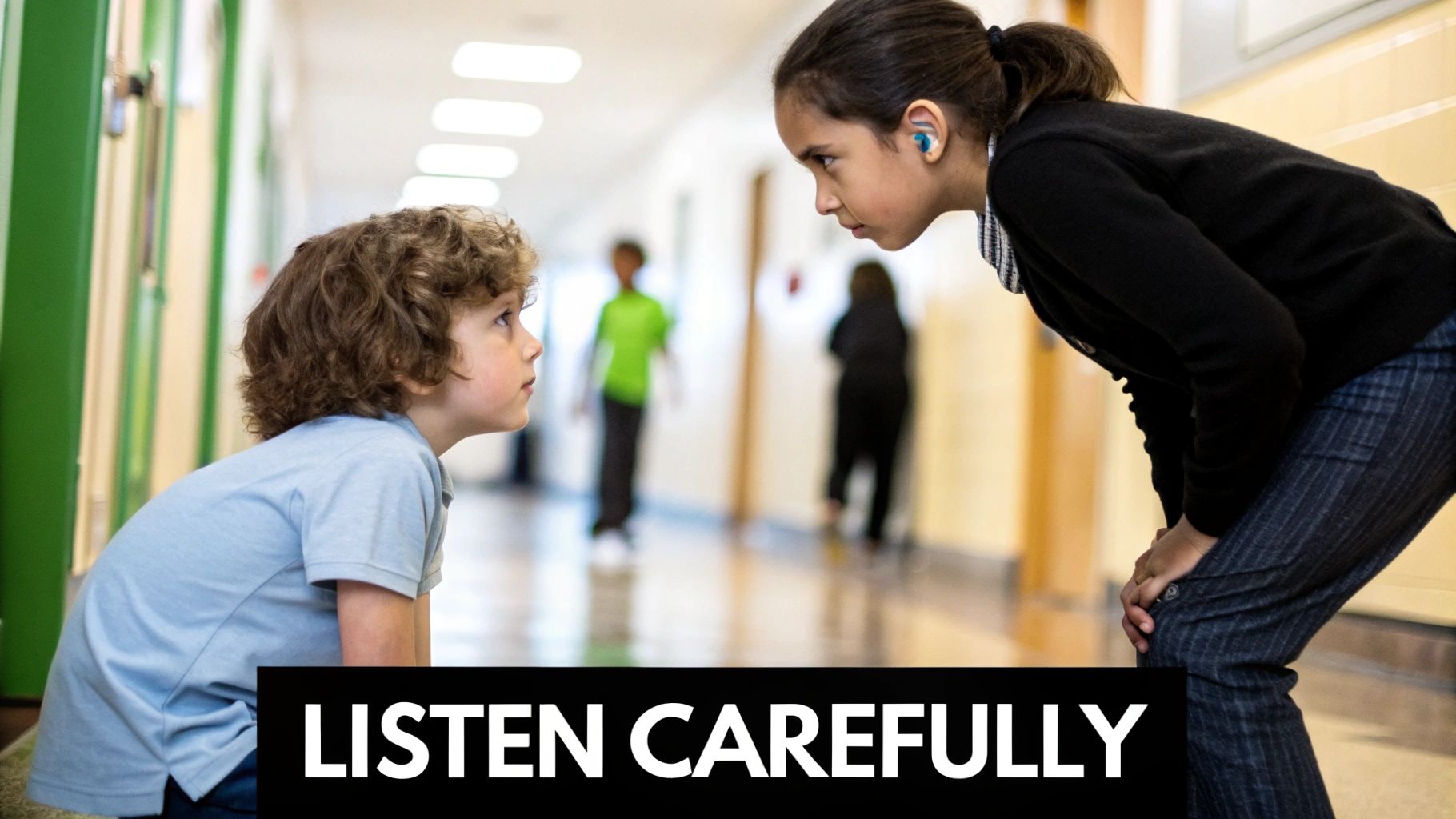
Before a child can even begin to navigate a disagreement, they need to make sense of the storm of feelings brewing inside them. This is where we come in. Building their emotional toolkit is the absolute foundation for all effective conflict resolution techniques for kids. It’s about giving them the words to match their feelings, turning a confusing jumble into something they can name, understand, and eventually, manage.
The whole process starts with one simple thing: validation. Every single feeling your child has—from pure rage over a broken toy to the quiet sting of being left out—is real and valid. Our job isn't to shut these emotions down, but to teach our kids that whilst all feelings are okay, not all actions are.
Naming Feelings to Tame Them
One of the most powerful things you can do is become an emotional narrator for your child. When you see them struggling, simply put a name to what you think they're experiencing. This small act does two massive things: it shows them you see their struggle, and it hands them the vocabulary they desperately need.
So, instead of a knee-jerk "Don't get upset," try framing it differently:
- "I can see you're feeling so frustrated because that LEGO tower keeps falling down."
- "It looks like you feel a bit left out right now."
- "Are you feeling disappointed that we have to leave the park?"
This approach isn't just about building their emotional vocabulary; it’s about modelling empathy. You're showing them how to recognise and acknowledge feelings in others, which is a critical skill for sorting out squabbles later on. A huge part of this is helping children master emotional regulation, so they can respond thoughtfully rather than just react. For parents wanting to dive deeper, you can learn more about what is emotional regulation and how to master it from the experts.
A child’s mental health is profoundly shaped by their ability to understand and express their emotions. When we help them build this toolkit, we are giving them a lifelong gift of emotional resilience.
Practical Ways to Build Emotional Literacy
So how do we make this a part of everyday life? The key is to weave it in naturally, rather than making it feel like a formal lesson. These small, consistent actions have a huge impact over time.
Consider adding a 'feelings wheel' to your bedtime routine. It’s a wonderful, low-pressure way for a child to simply point to how their day felt, opening up small conversations.
Another brilliant strategy is creating a 'calm-down corner'. This isn't a naughty step or a punishment zone. It’s a safe, cosy space with soft cushions, sensory toys, or a few favourite books. It teaches children that it's okay to take a moment to cool down when feelings get too big, giving them a constructive alternative to lashing out.
- Relaxation Tips: When your child is upset, try simple breathing exercises together. You can make it fun by calling it 'dragon breathing' (breathing in through the nose, and out through the mouth like a fiery dragon) or 'balloon breathing' (imagining their belly is a balloon they are slowly inflating and deflating). These techniques are physical anchors that help regulate their nervous system when things feel out of control.
Age-Appropriate Emotional Vocabulary Building
Building this vocabulary isn’t a one-size-fits-all process. What works for a toddler will be very different from what a ten-year-old needs. The goal is to meet them where they are developmentally.
The table below offers a simple guide for introducing emotional concepts at different stages, helping you tailor your approach as they grow.
| Age Group | Core Focus | Practical Example |
|---|---|---|
| Toddlers (1-3) | Simple, primary emotions | "You're sad because mummy is leaving." Use picture books with expressive faces. |
| Preschoolers (3-5) | More complex feelings and their physical signs | "I can see you're excited! Your hands are flapping and you're giggling." Connect the feeling to the action. |
| Early School (6-8) | Nuanced emotions and empathy for others | "He looks lonely on the bench. I wonder how he's feeling." Start to explore others' perspectives. |
| Pre-Teens (9-12) | Abstract feelings and coping strategies | "It sounds like you feel anxious about the test. Let's talk about what we can do to feel more prepared." |
Remember, this is just a starting point. The real magic happens in the day-to-day conversations, where you show them that talking about feelings is a normal, healthy part of life.
The Social Media Challenge
For older children, the emotional landscape gets a lot more complicated with the introduction of social media. An online disagreement can feel intensely public and overwhelming. It's vital to have open, non-judgemental conversations about the impact of likes, comments, and the carefully curated lives they see online. Research shows a clear link between higher social media use and poorer mental health outcomes in adolescents.
Talk to them about how online interactions can make them feel. Discuss the difference between a real-life disagreement and an online pile-on. This dialogue helps them build the critical thinking skills needed to protect their own mental wellbeing in digital spaces.
Ultimately, building this emotional toolkit is an ongoing process of conversation, modelling, and gentle guidance. It's one of the most important investments you can make in your child’s long-term mental health and their ability to form strong, healthy relationships for the rest of their lives.
Core Conflict Resolution Techniques You Can Teach Today
Once we've laid that emotional groundwork, we can start introducing the practical, hands-on strategies. These aren't complicated theories, but simple, memorable tools that can turn conflict from a battleground into a genuine learning opportunity. Think of them as the building blocks for healthy communication.
The goal here is to shift your role. You stop being the family referee, deciding who’s ‘right’ and who’s ‘wrong’, and instead become a coach. You’re guiding your children towards finding their own solutions. It's a subtle but powerful change that builds their confidence and, believe it or not, can actually strengthen their bond.
The Power of the Talking Stick
One of the biggest hurdles in any disagreement is the constant interrupting. When a child feels they aren’t being heard, they don’t back down—they just get louder and more frustrated. The 'Talking Stick' is a brilliantly simple concept that solves this problem almost instantly.
The rule is straightforward: only the person holding the designated object is allowed to speak. It can be anything you have to hand—a decorated kitchen roll tube, a special stone from the garden, or a favourite toy. When one person has finished speaking, they pass the stick to the other, signalling it's now their turn to talk, completely uninterrupted.
This does more than just enforce politeness. It actively teaches listening and forces a natural pause into the heat of the moment, which can bring the emotional temperature down a few notches. It validates each child’s voice, ensuring even the quieter sibling gets their full say.
Creating a Cool-Down Corner
Let's be realistic: sometimes, feelings are just too big to talk through straight away. A child in the grip of intense anger or frustration simply can't access the logical part of their brain needed for problem-solving. A 'Cool-Down Corner' is a designated safe space where they can go to regulate their emotions before trying to resolve the conflict.
It's crucial to frame this as a supportive tool, not a punishment. This is not the naughty step. It’s a cosy spot with soft cushions, maybe a weighted blanket, some colouring books, or a few sensory toys.
You can say something like, "I can see you're feeling really overwhelmed right now. Why don't you take a few minutes in your calm corner to help your body feel better? We can talk about this when you feel ready."
This practice teaches children to recognise their own emotional limits and gives them a healthy, independent strategy for managing them. It’s a vital life skill that builds self-awareness and stops disagreements escalating into shouting matches.
This flow chart visualises the core process of guiding a child from an emotional reaction to a place of understanding.
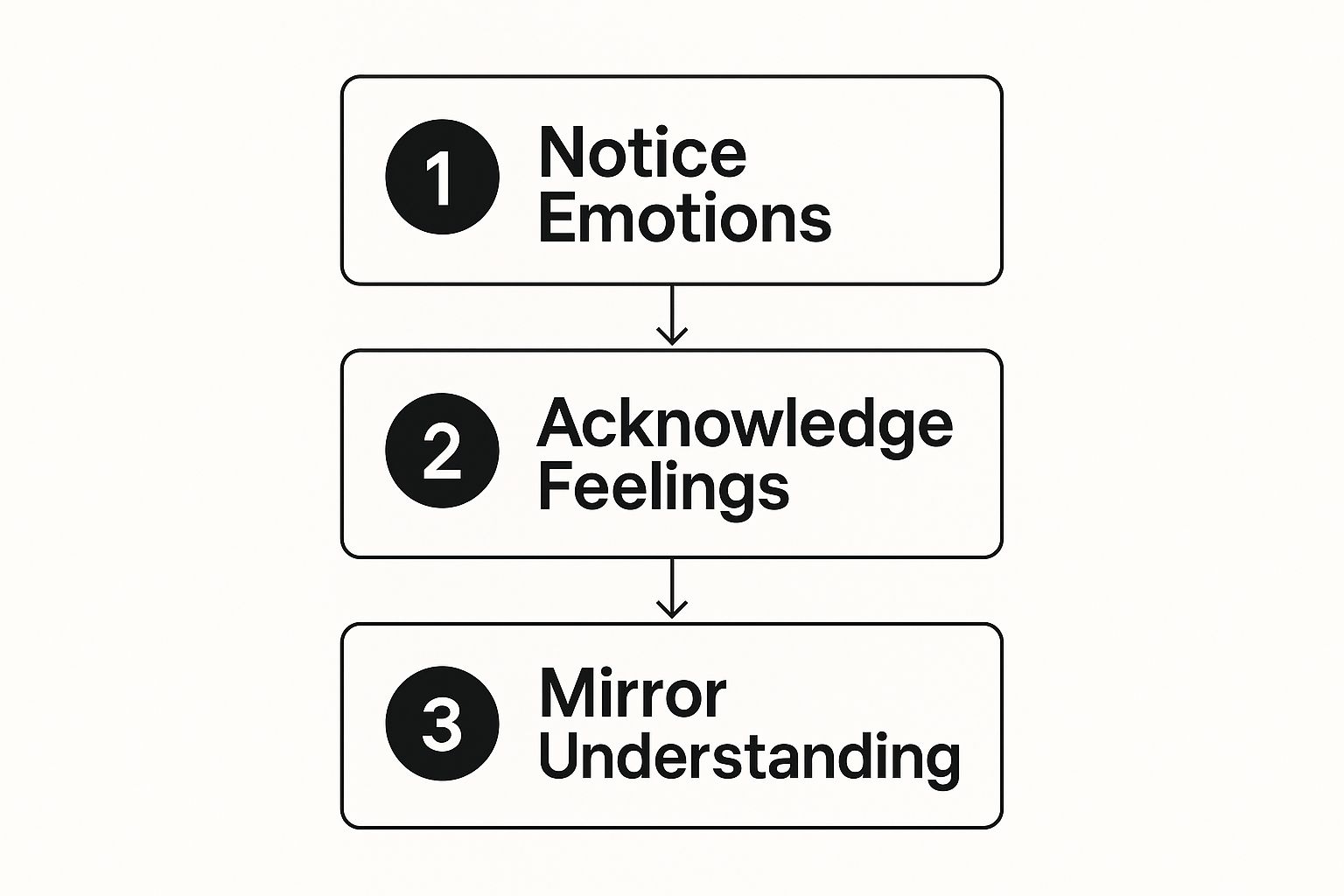
This simple, three-step model—Notice, Acknowledge, Mirror—is the foundation for helping children feel seen and understood before you even start trying to solve the problem.
Mastering 'I-Statements'
One of the quickest ways for a conflict to spiral out of control is using blaming language. Phrases like "You always..." or "You made me..." immediately put the other person on the defensive. 'I-Statements' are a powerful way to shift this dynamic completely.
This technique encourages children to take ownership of their feelings and express what they need without attacking their sibling. The structure is simple:
- "I feel..." (name the emotion)
- "...when you..." (describe the specific action, not the person)
- "...because..." (explain why it affects you)
- "I would like..." (state a positive need or a solution)
Let's see it in action.
Scenario: A Sibling Argument Over a Tablet
Instead of: "You're so selfish! You never let me have a turn!"
An I-Statement sounds like: "I feel frustrated when you keep playing on the tablet after the timer goes off, because I've been waiting for my turn. I would like us to stick to the timer so we both get a fair go."
See the difference? This reframing isn’t just about swapping words; it’s about shifting from blame to clear communication. It takes practice, for sure, but modelling this language yourself during your own disagreements is the most effective way to teach it. All these strategies are central pillars of what is social emotional learning and its massive impact on child development.
Seeking a Win-Win Solution
The ultimate goal of healthy conflict resolution isn’t for one person to win and the other to lose. It's about finding a solution where both people feel their needs have been met, at least in part. After feelings have been shared using tools like the Talking Stick and I-Statements, you can guide them towards brainstorming a 'win-win' outcome.
Try asking open-ended questions like:
- "What's a solution that could work for both of you?"
- "How can we make this fair for everyone involved?"
- "What's one thing you could each agree to do differently next time?"
This collaborative problem-solving phase turns them from adversaries into teammates working against a common problem. It’s a profound shift that builds empathy and strengthens their relationship in the long run.
How to Practice and Reinforce Positive Behaviours
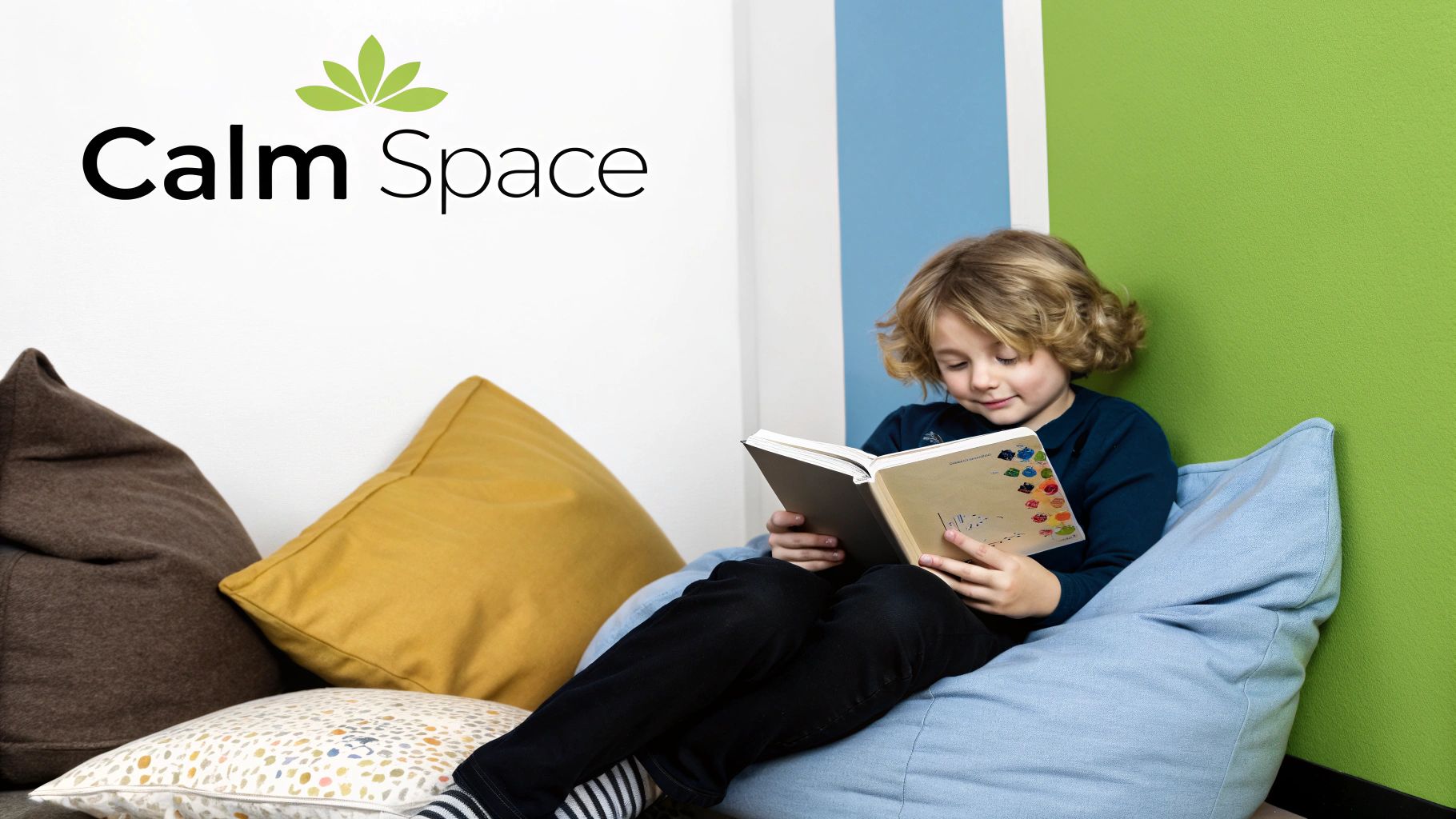
Knowing the theory is one thing, but the real magic happens when these conflict resolution skills become second nature for your child. It’s all about practice and reinforcement, turning abstract ideas into habits they can actually use. This isn't about formal lessons; it's about weaving these skills into the fabric of your family life.
The good news is that practice can be playful. For younger children, puppets or dolls are brilliant tools. You can act out a simple squabble—maybe two teddies wanting the same toy car—and explore different solutions together. Guide the puppets to use their 'I-Statements' or take turns holding a special 'talking stick'. It keeps things light and fun.
With older kids, you can draw on things they're already watching or reading. Try pausing a TV show and asking, "How do you think they could've sorted that argument out better?" It’s a great way to get them thinking critically about social situations without the emotional pressure of being in one themselves.
You Are the Most Important Role Model
More than any lesson we teach, our children learn from watching us. They are little sponges, soaking up how we handle our own disagreements, whether it's with a partner, a friend, or even a frustrating call centre operator. Our actions set the standard for what they see as normal and effective.
When you find yourself in a disagreement, try thinking out loud. It can be as simple as saying, "I'm feeling a bit cross right now, so I’m going to take a few deep breaths before we talk this through." Modelling that kind of self-awareness is incredibly powerful. It shows them that big feelings happen to adults too, and there are healthy ways to manage them.
Remember, the aim isn't to never disagree in front of your children. It's to show them what healthy, respectful disagreement looks like—complete with compromise, listening, and making things right afterwards.
The Power of Genuine Praise
One of the most effective things you can do is to catch them getting it right. When you see your child attempting to use a technique you've talked about, acknowledge it with specific, genuine praise. It makes a huge difference.
Forget a generic "Good job." Get descriptive with it:
- "I really loved how you used your words to tell your brother you were feeling frustrated. That was so clear."
- "Suggesting you take turns with the game was incredibly kind. You found a brilliant win-win solution."
- "Thank you for listening so carefully whilst your sister was speaking. I could see you were really trying to understand her."
This idea of encouraging good habits is a cornerstone of parenting. For instance, many successful potty training positive reinforcement techniques are built on the exact same principle: celebrating the positive steps they take.
Creating a Supportive Environment
Little nudges and resources in their environment can make a big impact. Reading books together that explore emotions and problem-solving is a wonderful, gentle way to start conversations. A classic like 'The Huge Bag of Worries' by Virginia Ironside can help normalise feelings of anxiety and open up a chat about how to cope. It’s just one of many fantastic emotional literacy activities that build a solid foundation.
Even small things like clothing with positive mental health messages, such as "It's Okay to Feel," can serve as a daily visual cue. This type of mental health apparel helps normalise talking about feelings, creating a home where children feel safe enough to express themselves and work through challenges.
Navigating Setbacks and When to Seek Help
https://www.youtube.com/embed/SrlYkx41wEE
Let’s be honest, teaching kids about conflict resolution is a journey, not a quick fix. There will absolutely be days when it feels like every single technique you've taught has gone straight out of the window.
You might have one child who flat-out refuses to talk it out, another who seems to always be the one pushing buttons, or a tiny disagreement that somehow explodes into a full-blown meltdown. This is all completely normal.
These setbacks aren't a sign that you've failed. They're just part of the learning curve for everyone involved. The real trick is to meet these moments with a bit of compassion and curiosity, rather than letting frustration take over. Ask yourself: what's really going on here? Is my child just tired, hungry, or feeling overwhelmed by something else entirely?
Often, what we see on the surface is a reaction to much bigger things. A child's mental health can be a mirror of the world around them. External pressures, like financial stress, can have a huge impact on the whole family's dynamic. It's a tough reality that in the UK, parental conflict is twice as likely in couple-parent families without work compared to those where both parents are employed. It’s important to recognise how these wider stresses can shorten everyone's fuse and make finding a peaceful resolution feel like an impossible task.
The good news is that targeted UK initiatives are making a real difference, with 80% of trained practitioners feeling better equipped to help families navigate these challenges. If you're interested, you can read the full report on reducing parental conflict to see what's working.
Knowing When to Get Professional Support
While most of these hurdles are a typical part of growing up, some behaviours might hint at a deeper issue that could use some professional attention. The most important thing is to trust your gut. You know your child better than anyone, and if something feels consistently off, it's always worth seeking advice.
Just a quick reminder, I am not a mental health professional. The following points are just general indicators. If you have any worries at all about your child's wellbeing, your first port of call should always be your GP or a qualified child psychologist.
Here are a few signs that might suggest it’s time to seek help:
- Extreme Aggression: This isn't just a bit of shoving. We're talking about persistent physical aggression—hitting, biting, kicking—that doesn't seem to improve no matter what you try.
- Significant Withdrawal: Your child becomes unusually quiet and withdrawn, starts avoiding friends, or just seems sad and anxious for a prolonged period.
- Drastic Changes in Behaviour: You notice big shifts in their sleeping or eating habits, or a sudden dip in their school performance that lasts for several weeks.
- Self-Harm or Talk of It: Any mention of wanting to hurt themselves should be taken seriously and addressed immediately.
- An Inability to Cope: It seems like your child is constantly overwhelmed by their emotions, with meltdowns that are incredibly intense and difficult to calm down from.
Taking the First Step
Reaching out for help is a sign of strength, not a weakness. Your GP is a great starting point. They can rule out any underlying physical causes and refer you to specialised services like Child and Adolescent Mental Health Services (CAMHS). Getting to grips with the basics of how to support a young person in crisis is also invaluable; our guide on youth mental health first aid offers some practical advice for parents and carers.
Seeking professional guidance is about giving your child the best possible support. It’s a proactive and loving step towards ensuring their long-term mental and emotional health.
Getting through these challenges requires a huge amount of patience and self-compassion. Please remember to look after your own mental health, too—you can't pour from an empty cup. When things feel tough, fall back on simple things like deep breathing or a moment of mindfulness. By staying calm and reaching out for support when you need it, you’re building a secure foundation for your child to continue to learn and grow.
Common Questions About Teaching Kids to Handle Conflict
Even when you have a solid plan, teaching kids to navigate disagreements can throw up some tricky real-world problems. Let's walk through some of the most common questions I hear from parents, with some practical advice to help you guide your children with confidence.
How Do I Teach Conflict Resolution to My Toddler?
When you're dealing with toddlers, the key is to keep it incredibly simple. Your focus should be on building emotional literacy, not teaching complex negotiation skills.
Start by just naming their feelings in the moment: "You feel so angry because she took your toy." This simple act helps them connect a word to their huge emotions.
Introduce really basic concepts like using "gentle hands," and don't be afraid to physically guide them through the motions. A visual timer can be a lifesaver for teaching turn-taking, and a dedicated "calm-down corner" with a few soft cushions gives them a safe space to manage those big feelings before they completely take over. It’s all about constant repetition and you modelling the behaviour you want to see.
What If One of My Children Always Dominates the Other?
This is such a common family dynamic, so you're not alone. The most important shift you can make is from being a referee to being a coach. Your job isn't to declare a winner, but to help them find a way to balance that power dynamic themselves over time.
A brilliant tool for this is a "talking stick" (or a teddy, or a specific cushion – anything works!). The rule is simple: only the person holding the object is allowed to speak. This gives your quieter child a guaranteed, protected, and uninterrupted turn to share their side of things.
Try prompting your more dominant child to think about the other side. Ask something like, "How do you think your brother felt when that happened?" Then, you can coach your quieter child on using a firm voice and clear 'I-statements' to express themselves.
This approach gives both children the specific skills they need to start navigating their relationship a little more fairly.
My Child Tries These Skills but Their Friends Don't. What Should I Do?
This is a really tough one, but it’s a vital lesson in resilience. The very first thing to do is validate how your child is feeling. Don't brush it off. Say something like, "It sounds so frustrating when you use your words and your friend just keeps shouting."
Next, you can role-play what they could do in that situation. This might be practising walking away to find a grown-up, or learning to say firmly, "I don't want to play like this anymore." Reassure them that they are doing the right thing by being kind and respectful, even if others aren’t. You'd be surprised how often their consistent, positive behaviour can eventually influence their friends.
Should I Ever Just Let My Children Fight It Out?
It’s so tempting, I know. But letting them "fight it out" usually just teaches them that the strongest, loudest, or most aggressive person wins. It reinforces a power struggle rather than teaching communication and compromise, which is the whole point.
Instead of letting things escalate, step in as a guide, not a judge. You can say, "Okay, I can see you two have a problem here. What’s one solution that would feel fair to both of you?" This steers them back towards the conflict resolution techniques for kids you've already been working on. The ultimate goal is to be able to gradually step back as they get better at it, not to abandon them in the middle of a battle.
At Little Fish Books, we believe that nurturing emotional intelligence is one of the greatest gifts you can give a child. Our collection of books, activities, and resources is designed to help you open up conversations about feelings and build a strong foundation for their mental wellbeing. Explore our supportive tools and start building your child's emotional toolkit today at https://thatsokay.co.uk.
